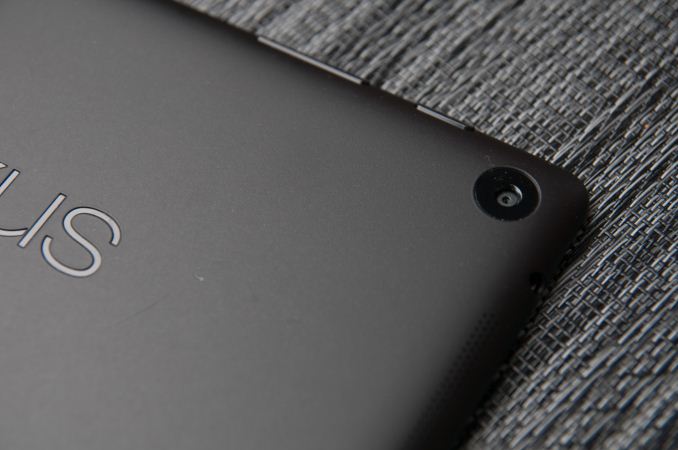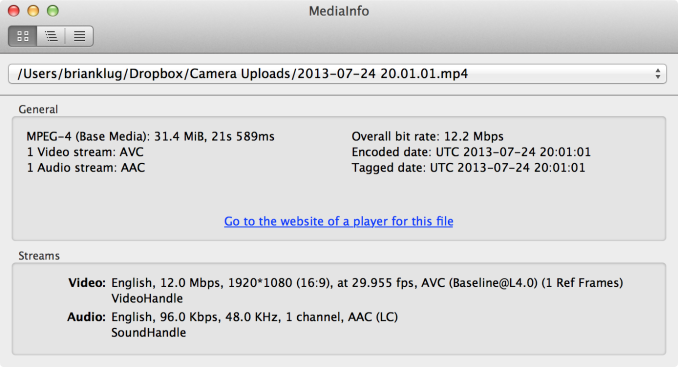Nexus 7 (2013) - Mini Review
by Brian Klug on July 27, 2013 12:54 AM EST- Posted in
- Tablets
- Snapdragon
- Qualcomm
- Android
- Mobile
- APQ8064
- Nexus 7
- Android 4.3
The lack of a rear camera on the original Nexus 7 was always a bit of a downer. It clearly had the space for a module inside, but including a camera didn’t align with the efforts to drive that device into the price point that made it successful. With the new Nexus 7 we finally get a camera, and a 5 MP one with autofocus at that. Inside the camera is an OV5693 sensor, which best I can tell is a 1/4" format sensor with 1.4 micron pixels. It might not be the world’s best camera, but it’s no slouch either.
I took a handful of photos and videos with the Nexus 7 (2013) to gauge camera quality, and even if this isn’t necessarily a device with focus on imaging it’s not bad at all. I came away pretty pleased for what kind of camera it is. Even though I still strongly believe that you shouldn’t be using a tablet to take photos you intend on using for anything more than sharing on social networks, in this brave new era of mobile devices it’s a feature every tablet and smartphone does need.
I’ll save you the discussion once again about how the Android 4.3 camera UI continues to present a 16:9 aspect ratio crop of the 4:3 image captured by the sensor, which results in a smeary looking, inaccurate preview.
Video on the Nexus 7 (2013) is 1080p30 at 12 Mbps, H.264 Baseline with 1 reference frame, and 96 kbps 48 KHz single channel AAC audio. I've uploaded a sample I took in SF to our servers as well as YouTube. Again I’m dismayed why more OEMs don’t use the full encode capabilities of APQ8064 (20 Mbps H.264 High Profile) but that’s what it is by default on the new Nexus 7.



















252 Comments
View All Comments
Krysto - Sunday, July 28, 2013 - link
Or maybe you're just not paying attention. They said they sold over 7 million Nexus 7's.abazigal - Sunday, July 28, 2013 - link
Is there any mention of its battery life in real-world tests?kmand - Sunday, July 28, 2013 - link
Does it support NEON? I know the Tegra-3 did.Wombat2013 - Sunday, July 28, 2013 - link
It would be helpful if the upcoming full review would address:- OTG compliance
- Slimport output testing
There have been varying opinions online about whether/how well these features work on the Nexus 7 (2013). (Not surprising - opinions, not AT real testing..)
Written from my new Nexus 7.
bznotins - Sunday, July 28, 2013 - link
Thanks for the great review, Brian. Definitely "mini" in name only and typical of why Anandtech is my most reliable tech review source.On going to hold-out for the LTE version with the hope that it can/will allow me to use it as a mobiles hotspot and replace my TMob Sonic 2.0 LTE hotspot. I know the 4G Nexus 7 stock wasn't capable of operating as a hotspot but I have my fingers crossed for the new LTE version.
Any speculation on a release date? "Weeks" feels pretty nonspecific.
yun - Sunday, July 28, 2013 - link
Pity no Tegra 4, my friend Squall-le am disappoint.kgh00007 - Sunday, July 28, 2013 - link
Hi, what link speed does the new nexus 7 connect with on 2.4 & 5Ghz? The OG nexus 7 only connected at 65Mbps?Cheers!
jojo98 - Sunday, July 28, 2013 - link
When testing WiFi, average throughput is nice but you should measure the variance as well. Even better would be under controlled interference if you have a lab setup to do it. Maybe a time graph vs data rate and latency would be nice.I'd rather have a consistent 20 Mbps connection than 100 Mbps average one that varies a lot in both data rate and latency. These kinds of things will show in voice and video over IP applications where the quality will be reduced when even only a short hit in speed and or latency occurs. Streaming sites like Netflix, Amazon and others will also reduce quality. The low quality will persist for a while even when your WiFi link gets better right after the dip.
MarkP23 - Monday, July 29, 2013 - link
Yes, only testing the average WiFi throughput is like only testing sequential accesses to SSDs when it comes to gauging what real world experience would be like.We need to know how stable the connection is over a prolonged amount of time (how much latency and data rate changes). All too often my WiFi connection blips during a Skype call or video stream causing the app to lower the quality. Even if it's only a momentary blip, most applications' algorithms won't immediately go back to the original quality. It may take minutes or until you reconnect because you can't stand watching blocky video and tinny audio.
bobak - Sunday, July 28, 2013 - link
Whilst AnadTech's articles and reviews are always excellent, the first place I go to read up on devices / components, a simple fact remains.Companies can bring out as many new android phones as they like, high spec, huge screens, packed with features... but they all run android. I tried it, i didn't like it. I tried it again and again and I still absolutely hate it. It feels old, clunky, disjointed, overcomplicated, ugly and not at all intuitive.
I'll be the first to admit, this is entirely based on my personal opinion, however every single person I know who has bought an android phone has turned round to me and asked "how much do you reckon i'll get for this on ebay... i hate it" within the first month.
Great article, i'll keep on reading them and enjoying them, but I just feel android misses the mark by a long shot. I'd rather a Windows phone - at least the OS looks and feels nice.
I'm well aware i'll probably get a load of replies telling me how I'm a fanboy or hater or whatever, but at least I tried to like it with an open mind, several times.